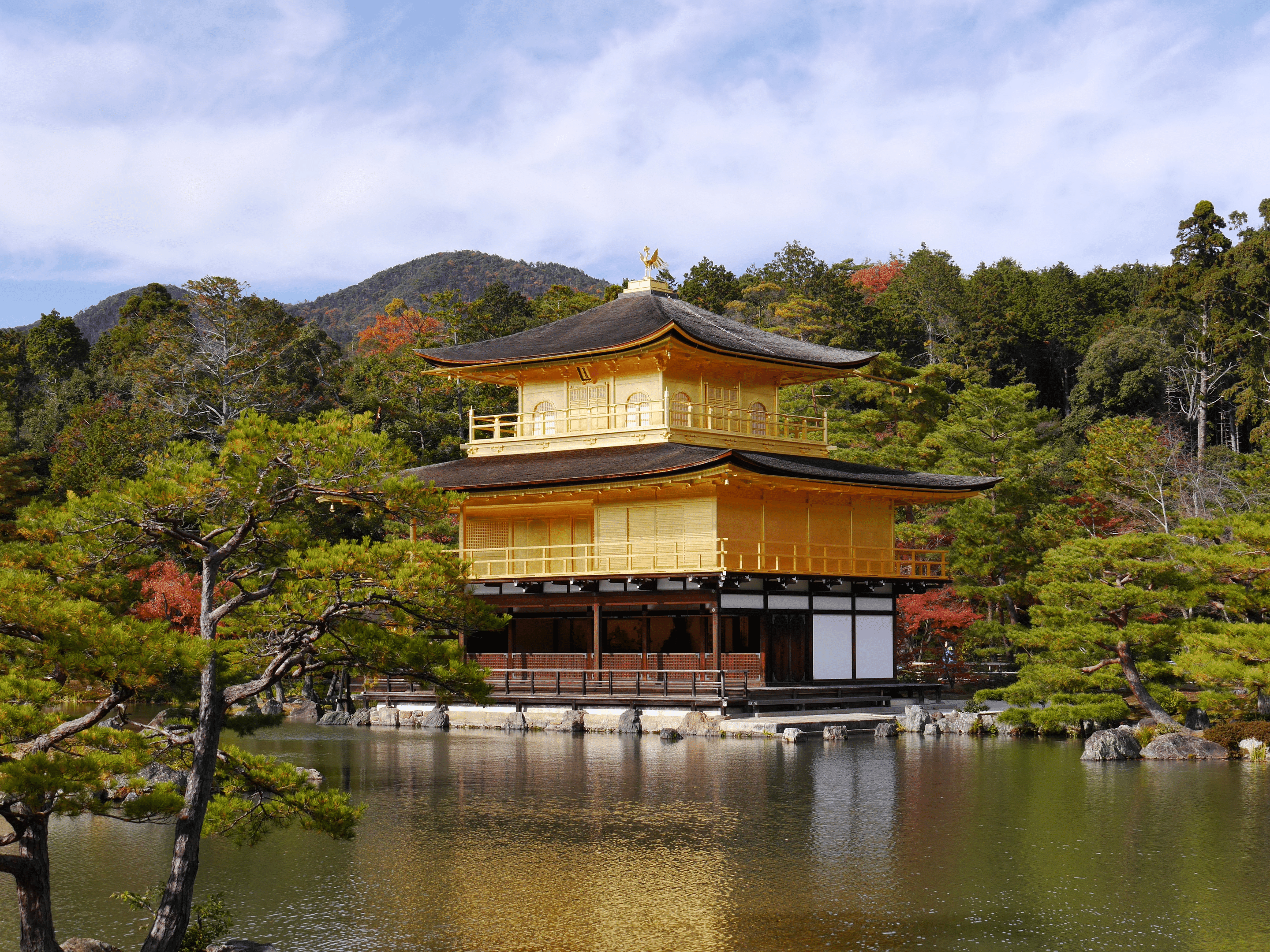Famously known as the Golden Pavilion, Kinkaku-ji Temple is one of Kyoto’s most iconic landmarks, which was originally built in 1397. This Buddhist temple was officially named Rokuon-ji and is known for its stunning architecture and scenic beauty. Originally, the temple was constructed as a retirement villa; however, shogun Ashikaga Yoshimitsu converted it into a zen temple. Visiting Kinkaku-ji Temple is a must on any Japan trip.
The temple's top two floors are covered in gold leaf, reflecting beautifully in Kyoko-chi pond, creating a serene view. Each floor of the temple has a different architectural style. The first floor displays the Shinden style, whereas the second floor uses the Bukke style in samurai residences, and the third floor uses the Chinese Zen Hall style. The temple grounds feature lush gardens, stone lanterns, and tranquil walking paths, allowing travelers to unwind and relax after a hectic day at work. Regarded as a UNESCO World Heritage Site, Kinkaku-ji Temple is a popular shrine known for its religious significance and natural beauty.
Highlights
• Admire the architectural beauty of the Kinkaku-ji Temple along with the structure covered in gold leaf, reflecting beautifully in the surrounding pond.
• Indulge in scenic views of the pavilion’s mirror image in the tranquil pond.
• Explore the temple’s garden featuring stone lanterns, ponds, and a waterfall.
• Taste authentic Japanese tea with picture-perfect pavilion views.
• Indulge in some souvenir shopping outside the temple.
How To Reach
By Car: Kinkaku-ji Temple is located 7 km from the Kyoto city center. It will take 20 minutes to visit your destination by car. For cheaper options, take an auto to reach your destination.
By Foot: Kinkaku-ji Temple is located 7 km from the Kyoto city center. It will take 1 hour and 10 minutes to visit your destination.
Best Time To Visit
Kinkaku-ji Temple can be visited throughout the year. Winter is an ideal time to explore the Kinkaku-ji Temple. The weather remains soothing throughout the day. Plan your visit to the Kinkaku-ji Temple on the weekends. Head to the Kinkaku-ji Temple in the early morning for a comfortable experience.
Other Essential Information
- On your tour of the famous Kinkaku-ji Temple, wear comfortable clothes.
- Since it is a spiritual place, wear modest clothes.
- Carry snacks and water with you for a comfortable experience.
- Carry essentials such as hats, sunscreen, and other things with yourself.
- Keep the environment clean around you.
The Golden Pavilion or Kinkaku
Golden Pavilion is the centerpiece of the Kinkaku-ji complex. This three-story building clearly displays the beauty of Muromachi period architecture. Further, it blends different styles across its levels. The first floor, or the Chamber of Dharma Waters, is built in the Shinden style, reminiscent of Heian-period palaces, featuring natural wood and white plaster. The second floor, called the Tower of Sound Waves, is constructed in Bukke style, which is typical of samurai residences, and it is completely gilded with gold leaf on the outside. The third floor, the Cupola of the Ultimate, is in the Chinese Zen Hall style, also gilded and topped with a bronze phoenix. The gleaming gold leaf not only symbolizes the cultural opulence of the era but also reflects sunlight, creating a shimmering effect.
Kyoko-chi or Mirror Pond
Surrounding the Golden Pavilion is the Kyoko-chi, or Mirror Pond, which adds an aesthetic appeal to the beautiful Kinkaku-ji Temple. The reflective surface of the pond captures the image of the pavilion. It creates a breathtaking visual effect that varies with the seasons and the time of day. Scattered throughout the pond are small islands and rock formations. Each of them are designed to enhance the scenic beauty and symbolize different elements of Buddhist cosmology. Walking paths around the pond offer multiple viewpoints, each providing a unique perspective on the interplay of architecture and nature.
The Temple Gardens
The gardens of Kinkaku-ji are a masterpiece of Muromachi period garden design, embodying the Zen principles of simplicity and natural beauty. The strolling garden layout leads visitors through a series of picturesque scenes, including:
1 Anmintaku Pond: A smaller pond that never dries up, even during droughts, symbolizing eternal prosperity.
2 Ryumon-Baku Waterfall: A small but charming waterfall that adds a soothing auditory element to the garden.
3 Statue of Fudo Myoo: A stone statue of Fudo Myoo, a Buddhist deity, adds a spiritual dimension to the garden.
As you walk through the garden, you encounter various stone lanterns, pagodas, and well-kept plants, each contributing to the garden’s tranquil ambiance.
Sekka-Tei Teahouse
Located within the temple grounds is the Sekka-tei Teahouse, a delightful spot that offers a glimpse into the traditional Japanese tea ceremony. Built during the Edo period, this teahouse is positioned to provide a stunning view of the Golden Pavilion, which is particularly beautiful during sunset. The name Sekka-tei means “place of evening beauty,” reflecting its purpose as a space for quiet reflection and appreciation of the changing light. Visitors can enjoy a cup of matcha tea while soaking in the serene atmosphere and the picturesque views of the garden and pavilion.

